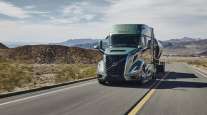Volvo Pushes Product Innovation Amid Slower Industrywide Sales

WASHINGTON — After Volvo Trucks North America’s best year for deliveries and market share in 2015, plans are under way to focus on the flatbed, tank truck and heavy-haul sectors to offset an industrywide sales slowdown, a strategy its president said could start to bear fruit in the second half of this year.
At a press event here Feb. 24, Volvo Trucks President Göran Nyberg and Magnus Koeck, vice president of marketing, said new products should aid the original equipment manufacturer’s sales efforts.
The OEM’s 6x2 power configuration with a lift axle has sold well, Nyberg said, and more truck buyers are spec’ing in-house engines, 93% of Volvos sold, and I-Shift transmissions, all automated manual, 83%.
As for the current landscape in truck sales, Nyberg said his “big accounts are now slowing down; that’s my gut feeling.” He said his core markets are regional and longhaul carriers, often pulling dry van or refrigerated loads. That is why he’d like to do more with flatbed, heavy-haul and tank carriers.
The company forecast for North American heavy-duty sales is 260,000 trucks this year, down from 301,740 in 2015. Still a good level for the industry, Nyberg said, but not as heady as before.
“For any carriers that are weight-sensitive, I think we can be extremely competitive,” he said.
Looking at environmental regulations, Nyberg said regulators and truck makers are working together better so as to avoid the boom-bust cycle of 2006-2007, when fleets rushed purchases early and shunned them later after emissions regulations tightened.
“Ten years ago, in 2006, we were forced into new standards without preparations,” Nyberg said of the regulatory changes that brought diesel particulate filters and more exhaust-gas recirculation to vehicles in 2007.
“Today, we need to do this together [with regulators]. We need time to do it right and bring about greater efficiency. We have matured together with the authorities,” he told editors and reporters in offices adjacent to the Swedish Embassy.
Gothenburg, Sweden-based Volvo Group changed its internal organization in January, switching to a focus on brand names from geography. That means Nyberg reports to Volvo Trucks chief Claes Nilsson in Sweden rather than Dennis Slagle in Greensboro, North Carolina. Slagle had been in charge of Volvo and sister company Mack Trucks for North America, but now he’s responsible for Mack only.
“We are laser-focused on each brand now,” Nyberg said.
Over the past 10 years, a lot of joint Mack-Volvo dealerships have sprouted. Koeck said dealer companies can keep both brands, but they should be run out of separate buildings.
“We’re actively supporting dedicated, separate brands but a common service department would be all right,” Nyberg said.
Despite the focus on brands, Nyberg said Volvo will not be making a one-world truck. The vehicles will be tailored to five major regions: North and South America, separately, Europe, Asia-Pacific and Africa-Middle East.
“I’ve been involved in many markets,” Nyberg said. “We sell mainly cabovers in Europe. North America is unique with the tonnage hauled, the distances involved and the size of our fleet customers. There are regional plans for each of the five regions.”
Koeck said that even within North America, Mexico is a substantial market that is different from the United States and Canada. Cabovers are more popular in Mexico, he said.
Last year, Koeck said, Volvo shipped 38,849 trucks out of its Dublin, Virginia, factory — the largest facility in the Volvo Trucks global network.
Market share was 12.4% in the United States, 16.3% in Canada and 4.9% in Mexico. For the whole continent, the share was 12.2% — all of the figures are records except for Mexico, Koeck said.
U.S. truck sales by Volvo were 30,930 vehicles, which even topped the industry’s record year of 2006, when Volvo sold 30,716 heavy trucks.
“We are pleased, but not happy,” Nyberg said.
Trucks made in 2017 will have to tighten carbon dioxide emissions by another 3% starting in January. Nyberg refused to say how the vehicles would do that, but the general strategy for emitting less CO2 is to burn less fuel by improving mileage.
Volvo has announced plans to discuss improvements in powertrain efficiency in late March, but Nyberg would neither confirm nor deny that those changes were related to the 2017 greenhouse-gas rules.
“Stay tuned,” he said cryptically.
One selling point Nyberg and Koeck mentioned was the 6x2 power configuration introduced last summer. They did not offer precise numbers, but “demand is greater than we can produce now,” Nyberg said.
If a truck is carrying a lighter load, the 6x2 can convert to a 4x2, and fewer axles on the road is more fuel-efficient. Koeck said he thinks the 6x2 might become like the company’s I-Shift automated manual transmission, which has grown steadily in popularity among customers over a period of years.




